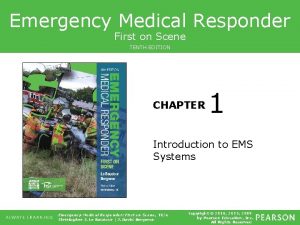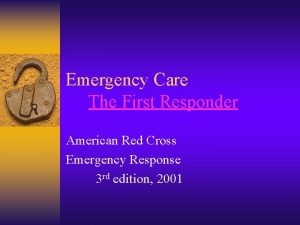Using Emergency Medical Services EMS Data to Assess

- Slides: 1

Using Emergency Medical Services (EMS) Data to Assess Personal Protective Equipment Reporting by Illinois EMS Providers in Response to the 2014– 2016 Ebola Outbreak in West Africa Livia § 1, 2 Navon , Daniel 1 Lee , and Lisa 3 Diep 1. Illinois Department of Public Health 2. Division of State and Local Readiness, Office of Public Health Preparedness and Response, CDC 3. University of Illinois at Chicago, School of Public Health Figure 1. Exclusion Criteria and Data Included in Each Analysis Figure 3. Trend Analysis of Reported PPE Use for Patients Background Exclusion Criteria with Non-Infectious Symptoms, Illinois, 2013 – Total Ambulance Runs During the 2014– 2016 Ebola Outbreak in Ambulance run cancelled, no patient 2015 2, 916, 556 (100%) found, patient refused care, no treatment required West Africa, and the subsequent arrival of travelers to the U. S. , CDC issued guidance for EMS providers regarding use of personal protective equipment (PPE) 2, 644, 970 (90. 7%) Runs by agencies who always reported PPE usage or never reported PPE usage § EMS providers in Illinois report data on each ambulance run to the Illinois Department of Public Health including PPE utilized on each run § We examined ambulance run data to determine if during the time of heightened concern regarding domestic Ebola transmission (October 2014–June 2015), PPE utilization increased, particularly among patients with infectious symptoms compared to patients with non-infectious symptoms Methods § Illinois EMS data ambulance run data from January 1, 2013–December 31, 2015 were included in this analysis 271, 586 Eligible Runs + Reporting Agency Reported Variation in PPE Usage 469, 056 2, 175, 914 (74. 6%) (Figure 2) Symptoms missing, none, not applicable, not available, not known, not recorded or not reporting Eligible Runs + Reporting Agency Reported Variation in PPE Usage + Symptom Information 764, 880 1, 411, 034 (53. 3%) 2013 (Figures 3 and 4) 2014 2015 ^The Annual Percent Change (APC) is significantly different from zero at alpha=0. 05 Figure 2. Trend Analysis of Reported PPE Use, Patients with Any Symptoms, Illinois, 2013 – 2015 Figure 4. Trend Analysis of Reported PPE Use for Patients with Infectious Symptoms, Illinois, 2013– 2015 § Patients were classified as infectious or non-infectious based on primary symptoms reported by EMS providers § Join. Point regression software (available from the National Cancer Institute) was used to examine trends in self-reported PPE provider use by quarter Limitations § Data was missing for a large percentage of ambulance runs Results Slope not significant § 496 different EMS agencies entered 2, 644, 970 eligible runs into the statewide EMS system (range: 1– 699, 235 ambulance runs per agency) with a median of 1, 331 runs per agency (Figure 1) § 41% of eligible ambulance runs had no PPE use reported (PPE field was either marked as no applicable (20. 2%), not available (8. 1%), not known (0. 01%), not recorded (2. 4%) not reporting (0. 84%) or left blank (9. 3%) § EMS agencies that reported no variation in PPE usage were excluded (54 agencies reported no PPE usage and 45 agencies reported PPE usage for each run). These runs represented 17. 6% of eligible runs (Figure 1) § We first analyzed the trend in reported PPE use not accounting for patient symptoms. Although there was an increase during the time of heightened Ebola concern, this increase was not statistically significant (Figure 2) § We refined this analysis to take into account infectiousness of patient symptoms (Table 1). Data were excluded if patient primary symptoms were either missing or marked as not reported, not available, not known, not recorded or not reporting (28. 7% of eligible runs) 2013 2014 2013 Table 1. Categorization of Patient Primary Symptoms as Infectious and Non-Infectious, Ambulance Runs, Illinois, 2013– 2015 Infectious Non-Infectious Primary Symptom Malaise Bleeding Nausea/Vomiting Fever Drainage/Discharge Diarrhea Rash/Itching Number of Runs 67, 167 64, 209 38, 341 23, 107 9, 177 8, 167 5, 685 § On ambulance runs with non- infectious patients, the modeled average percent change (APC) increase in PPE use was 0. 39% per quarter (p<0. 05). No breaks in trend were statistically significant (Figure 3). § On ambulance runs with infectious patients, the APC was 0. 63% per quarter (p<0. 05). No breaks in trend were statistically significant (Figure 4). 2015 Primary Symptom Pain Change in responsiveness Breathing Problem Weakness Mental/Psych Transport Only Swelling Wound Death Palpitations Choking Device/Equipment Problem Total 215, 793 Mass/Lesion Total Number of Runs 478, 773 208, 229 162, 831 125, 221 123, 793 41, 527 17, 877 14, 866 10, 760 6, 869 1, 873 1, 401 1, 221 1, 195, 241 2014 2015 ^The Annual Percent Change (APC) is significantly different from zero at alpha=0. 05 Conclusions § Use of PPE increased linearly from January 2013–December 2015 for patients with infectious and non-infectious symptoms with a higher APC for infectious patients § There were no statistically significant breaks in the linear trend corresponding to the time of heightened concern about the 2014– 2016 Ebola Outbreak in West Africa, despite a slight increase in reported PPE use during October 2014–June 2015 Recommendations § Changes to the Illinois EMS PPE reporting system are needed to better capture use of PPE and patient symptoms by EMS providers § Education of EMS providers on importance of complete data capture may improve data quality

